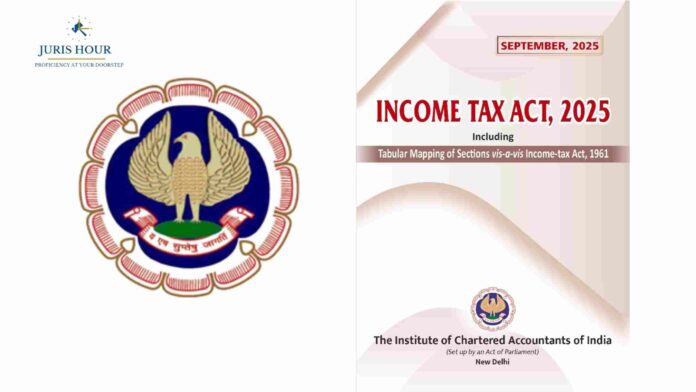The Institute of Chartered Accountants of India (ICAI) has released the Bare Law of the Income-tax Act, 2025, ushering in a landmark reform of India’s direct taxation system. Effective from April 1, 2026, the new law replaces the Income-tax Act, 1961 and is designed to be simpler, clearer, and more taxpayer-friendly.
The Act was first announced in the Union Budget 2024-25 and introduced as a Bill in the Lok Sabha on February 13, 2025. ICAI actively participated in drafting consultations, with over 90 of its suggestions accepted in the final legislation.
Below is a structured comparison highlighting how the Income-tax Act, 2025 differs from the Income-tax Act, 1961:
Comparative Overview of Income-tax Act, 1961 vs Income-tax Act, 2025
| Aspect | Income-tax Act, 1961 | Income-tax Act, 2025 |
| Drafting Style | Long, complex sentences; multiple provisos. | Concise drafting; reduced provisos; use of tables for clarity. |
| Terminology | Used “Previous Year” and “Assessment Year”. | Introduces “Tax Year” (Sec. 3) for simplicity. |
| Exemptions | Scattered across various sections. | Consolidated in structured Schedules II–VIII. |
| Deductions | Chapter VI-A with overlapping provisions. | Consolidated into clear categories: Payments, Incomes, Other Incomes, Disability, etc. |
| Capital Gains | Spread across multiple sections (45–55A, 54 series). | Consolidated under Sections 67–91, with clarity on slump sale, buyback, compulsory acquisition. |
| Special Provisions | MAT & AMT scattered, non-residents & pass-through entities in different places. | Unified provisions (Sec. 199–235) for MAT/AMT, non-residents, IFSC, pass-through entities, shipping. |
| Compliance | PAN, returns, and e-assessments fragmented. | Integrated compliance: Faceless assessments, Faceless information collection, and crypto-asset reporting (Sec. 509). |
| Taxpayer Charter | Brought via notifications, not statutory. | Statutory recognition of the Taxpayer’s Charter (Sec. 240). |
| Non-Profit Organisations | Governed by multiple scattered sections (11, 12A, 12AB, 115TD, etc.). | Dedicated chapter (Sec. 332–355) covering registration, income, violations, tax on accreted income. |
| Penalties | Scattered, with duplication (e.g., “reasonable cause” repeated). | Unified framework (Sec. 439–472), clearer offences in Chapter XXII (473–498). |
| Schedules | Limited to depreciation and certain exemptions. | Extensive use of schedules for exemptions, deductions, depreciation, specific businesses. |
ICAI’s Role and Outreach
Through its Direct Taxes Committee (DTC), ICAI organised 38 awareness programs across India to familiarise stakeholders with the draft law. ICAI President CA. Charanjot Singh Nanda said the new Act “empowers professionals and taxpayers alike,” while DTC Chairman CA. Piyush S. Chhajed stressed that reading the bare law will help professionals build sound interpretation skills.
Impact and Road Ahead
The Income-tax Act, 2025 is expected to:
- Make tax compliance easier for individuals and businesses.
- Reduce disputes through clearer provisions.
- Strengthen India’s position as a global investment hub.
- Support Prime Minister Narendra Modi’s vision of a developed, inclusive India.
With its implementation from April 2026, the law represents not just a replacement of the 1961 Act but a modernisation of India’s entire direct tax framework.
Read More: ED to Attach Properties of Celebrities in 1xBet Online Betting and Money Laundering Probe

